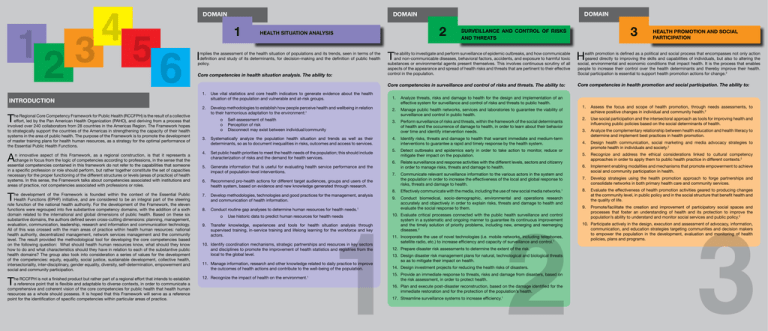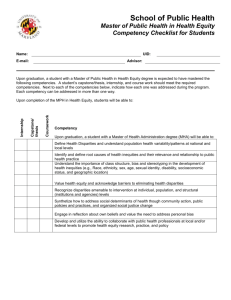1 2 3 DOMAIN
advertisement

DOMAIN 1 mplies the assessment of the health situation of populations and its trends, seen in terms of the definition and study of its determinants, for decision-making and the definition of public health policy. Core competencies in health situation analysis. The ability to: T he Regional Core Competency Framework for Public Health (RCCFPH) is the result of a collective effort, led by the Pan American Health Organization (PAHO), and deriving from a process that involved over 240 collaborators from 28 countries in the Americas Region. The Framework hopes to strategically support the countries of the Americas in strengthening the capacity of their health systems in the area of public health. The purpose of the Framework is to promote the development of master training plans for health human resources, as a strategy for the optimal performance of the Essential Public Health Functions. A n innovative aspect of this Framework, as a regional construction, is that it represents a change in focus from the logic of competencies according to professions, in the sense that the essential competencies contained in this framework do not refer to the capabilities that someone in a specific profession or role should perform, but rather together constitute the set of capacities necessary for the proper functioning of the different structures or levels (areas of practice) of health systems. In this sense, the Framework talks about competencies associated with institutions and areas of practice, not competencies associated with professions or roles. T 1. Use vital statistics and core health indicators to generate evidence about the health situation of the population and vulnerable and at-risk groups. 2. Develop methodologies to establish how people perceive health and wellbeing in relation to their harmonious adaptation to the environment:1 o Self-assessment of health o Perception of risk o Disconnect may exist between individual/community 3. Systematically analyze the population health situation and trends as well as their determinants, so as to document inequalities in risks, outcomes and access to services. 4. Set public health priorities to meet the health needs of the population; this should include characterization of risks and the demand for health services. 5. Generate information that is useful for evaluating health service performance and the impact of population-level interventions. 6. Recommend pro-health actions for different target audiences, groups and users of the health system, based on evidence and new knowledge generated through research. he development of the Framework is founded within the context of the Essential Public Health Functions (EPHF) initiative, and are considered to be an integral part of the steering role function of the national health authority. For the development of the Framework, the eleven functions were regrouped into five substantive competency domains, with the addition of a sixth domain related to the international and global dimensions of public health. Based on these six substantive domains, the authors defined seven cross-cutting dimensions: planning, management, evaluation, communication, leadership, research and information and communication technology. All of this was crossed with the main areas of practice within health human resources: national health authority, decentralized management, network services management and the community level. The result provided the methodological tool for developing the core competencies based on the following question: What should health human resources know, what should they know how to do and what characteristics should they have in relation to each of the substantive public health domains? The group also took into consideration a series of values for the development of the competencies: equity, equality, social justice, sustainable development, collective health, intersectoriality, inter-disciplinary, gender equality, diversity, self-determination, empowerment and social and community participation. 7. Develop methodologies, technologies and good practices for the management, analysis and communication of health information. he RCCFPH is not a finished product but rather part of a regional effort that intends to establish a reference point that is flexible and adaptable to diverse contexts, in order to communicate a comprehensive and coherent vision of the core competencies for public health that health human resources as a whole should possess. It is hoped that this Framework will serve as a reference point for the identification of specific competencies within particular areas of practice. 12. Recognize the impact of health on the environment.1 T 2 HEALTH SITUATION ANALYSIS I INTRODUCTION DOMAIN DOMAIN 8. Conduct routine gap analyses to determine human resources for health needs.1 o Use historic data to predict human resources for health needs 9. Transfer knowledge, experiences and tools for health situation analysis through supervised training, in-service training and lifelong learning for the workforce and key actors. 10. Identify coordination mechanisms, strategic partnerships and resources in key sectors and disciplines to promote the improvement of health statistics and registries from the local to the global level. 11. Manage information, research and other knowledge related to daily practice to improve the outcomes of health actions and contribute to the well-being of the population. 3 SURVEILLANCE AND CONTROL OF RISKS AND THREATS HEALTH PROMOTION AND SOCIAL PARTICIPATION T H Core competencies in surveillance and control of risks and threats. The ability to: Core competencies in health promotion and social participation. The ability to: he ability to investigate and perform surveillance of epidemic outbreaks, and how communicable and non-communicable diseases, behavioral factors, accidents, and exposure to harmful toxic substances or environmental agents present themselves. This involves continuous scrutiny of all aspects of the appearance and spread of health risks and threats that are pertinent to their effective control in the population. 1. Analyze threats, risks and damage to health for the design and implementation of an effective system for surveillance and control of risks and threats to public health. 2. Manage public health networks, services and laboratories to guarantee the viability of surveillance and control in public health. 3. Perform surveillance of risks and threats, within the framework of the social determinants of health and the occurrence of damage to health, in order to learn about their behavior over time and identify intervention needs. 4. Identify risks, threats and damage to health that warrant immediate and medium-term interventions to guarantee a rapid and timely response by the health system. 5. Detect outbreaks and epidemics early in order to take action to monitor, reduce or mitigate their impact on the population. 6. Relate surveillance and response activities with the different levels, sectors and citizenry in order to manage risks, threats and damage to health. 7. Communicate relevant surveillance information to the various actors in the system and the population in order to increase the effectiveness of the local and global response to risks, threats and damage to health. 8. Effectively communicate with the media, including the use of new social media networks.1 9. Conduct biomedical, socio-demographic, environmental and operations research accurately and objectively in order to explain risks, threats and damage to health and evaluate the social response to them. 10. Evaluate critical processes connected with the public health surveillance and control system in a systematic and ongoing manner to guarantee its continuous improvement and the timely solution of priority problems, including new, emerging and reemerging diseases.2 11. Incorporate the use of novel technologies (i.e. mobile networks, including telephones, satellite radio, etc.) to increase efficiency and capacity of surveillance and control.1 12. Prepare disaster risk assessments to determine the extent of the risk. 13. Design disaster risk management plans for natural, technological and biological threats so as to mitigate their impact on health. 14. Design investment projects for reducing the health risks of disasters. 15. Provide an immediate response to threats, risks and damage from disasters, based on the risk assessment, in order to protect health. 16. Plan and execute post-disaster reconstruction, based on the damage identified for the immediate restoration and for the protection of the population’s health. 17. Streamline surveillance systems to increase efficiency.1 ealth promotion is defined as a political and social process that encompasses not only action geared directly to improving the skills and capabilities of individuals, but also to altering the social, environmental and economic conditions that impact health. It is the process that enables people to increase their control over the health determinants and thereby improve their health. Social participation is essential to support health promotion actions for change.2 1. Assess the focus and scope of health promotion, through needs assessments, to achieve positive changes in individual and community health.2 2. Use social participation and the intersectoral approach as tools for improving health and influencing public policies based on the social determinants of health. 3. Analyze the complementary relationship between health education and health literacy to determine and implement best practices in health promotion. 4. Design health communication, social marketing and media advocacy strategies to promote health in individuals and society.2 5. Recognize and address the ethical considerations linked to cultural competency approaches in order to apply them to public health practice in different contexts.2 6. Implement enabling modalities and mechanisms that promote empowerment to achieve social and community participation in health. 7. Develop strategies using the health promotion approach to forge partnerships and consolidate networks in both primary health care and community services. 8. Evaluate the effectiveness of health promotion activities geared to producing changes at the community level, in public policy and in the social structure that benefit health and the quality of life. 9. Promote/facilitate the creation and improvement of participatory social spaces and processes that foster an understanding of health and its protection to improve the population’s ability to understand and monitor social services and public policy.2 10. Participate actively in the design, execution and assessment of advocacy, information, communication, and education strategies targeting communities and decision makers to empower the population in the development, evaluation and monitoring of health policies, plans and programs. DOMAIN DOMAIN 4 DOMAIN 5 POLICY, PLANNING, REGULATION AND CONTROL E O Core competencies in policy, planning, regulation and control. The ability to: Core competencies for equitable access to quality individual and public health services. The ability to: very health system should be governed by periodically agreed upon health policies, plans and regulations. People who work in the health sector should have the necessary skills to manage regulatory frameworks for the protection and supervision of health. They should also have the skills needed to initiate and participate in the drafting of new laws and regulations for creating healthy settings and protecting citizens and to support international cooperation.2 6 EQUITABLE ACCESS TO QUALITY INDIVIDUAL AND PUBLIC HEALTH SERVICES ne of the prerequisites for public health practice is the effort to guarantee universal access to services with no barriers of any type, promoting quality and safety in their delivery and employing a multisectoral approach to eliminate inequities in the health care provided to the population. INTERNATIONAL / GLOBAL HEALTH T his is the inter-disciplinary approach that addresses health from the standpoint of the universal right to health and well-being. In a globalized and interconnected world, global approaches with local impact are needed that consider the social determinants of health and which, with equity, ethics and a respect for human rights move towards transnational, regional and global solutions that improve the health of all citizens of the world. International / global health uses tools that rely on the relationships between national health authorities through health diplomacy and technical cooperation. Core competencies in international / global health. The ability to: 1. Apply the basic conceptual, technical and methodological elements to develop, implement, monitor and evaluate health policy towards guaranteeing equity and the basic right to health.2 1. Support the principles of equity, using the social determinants approach, when designing and implementing health policies and activities to improve access to preventive and curative health services. 2. Protect the right to health in all public policies across sectors as a basic human right for the integral well-being of the population. 2. Implement plans, strategies and activities that increase equity in health service delivery to achieve social efficacy, health care effectiveness, cost-effectiveness and efficient distribution of the necessary resources for health care to the population.2 3. Administer the human, financial and technological resources required for improving health and monitoring its determinants to improve equity, inclusion and performance of primary care based health systems. 4. Assess the needs and problems of individuals, families, groups and communities to inform decisions on policy and legal interventions and to optimize outcomes.2 5. Lead interdisciplinary groups that work in a coordinated manner in the analysis, formulation, implementation and assessment of health policies, plans and programs to guarantee population rights and efficient health systems performance based on social determinants, i.e. “Health in all policies”.2 3. Design plans and implement practices, including monitoring and evaluation, that promote continuous quality improvement in the management and delivery of health care services.2 4. Promote quality assurance and safety standards to reduce existing gaps and inequities in health care delivery. 5. Participate in integrated care networks with the different levels of care to improve the system’s response to the population’s health problems. Regional Core Competency Framework for Public Health 1. Recognize the global dimensions of local health action to advance global responsibility. 2. Recognize the local implications of global health events to understand global interconnectivity and its impact on health conditions in the population.2 3. Promote transnational, intersectoral initiatives to overcome health inequities and implement effective interventions (including bilateral agreements related to the health workforce).2 4. Perform impact assessment of bilateral and multilateral agreements.1 5. Critically analyze the changing nature, key factors and resources that shape global health in order to influence health, well-being and social security reforms globally, and in particular in the Americas.2 6. Compare service delivery systems, which reflect diverse political, organizational and economic contexts, using these experiences to improve access, regulation and the financing of health systems.2 6. Participate in the implementation of health policies and plans to help guarantee the right to health, equity and efficient health system performance.2 6. Identify minimum or basic safety conditions in health care delivery, for the design and implementation of programs and activities for surveillance and risk management inherent to health service delivery. 7. Recognize that planning and decision-making are social, technical and political processes to guarantee better health outcomes. 7. Advocate for people’s right to treatment-with-respect and timely access, privacy and confidentiality at all stages and in all processes of health care.2 7. Contribute effectively to the care of vulnerable groups, especially migrants, travelers, transnational ethnic minorities and border populations, for the mitigation, eradication and/or control of global health problems. 8. Promote and participate in socially and culturally sensitive multidisciplinary teams that employ a community approach for the ongoing improvement of health services.2 8. Engage non-governmental organisations.1 organisations and encourage advocacy in these 9. Respect and value cultural diversity, regional efforts and global and intersectoral technical cooperation for the development of comprehensive initiatives that result in improved health care for populations. 10. Seek, identify, apply for, obtain, mobilize and account for international funds that are relevant to the country.1 11. Use funds from international and global health programs and research findings to develop and implement interventions that result in local action to benefit the health of the population.2 Key: 1 Core competency added by consultative group from the English-speaking Caribbean. 2 Some concepts added and/or changes made by consultative group from the English-speaking Caribbean. Regional Core Competency Framework for Public Health





